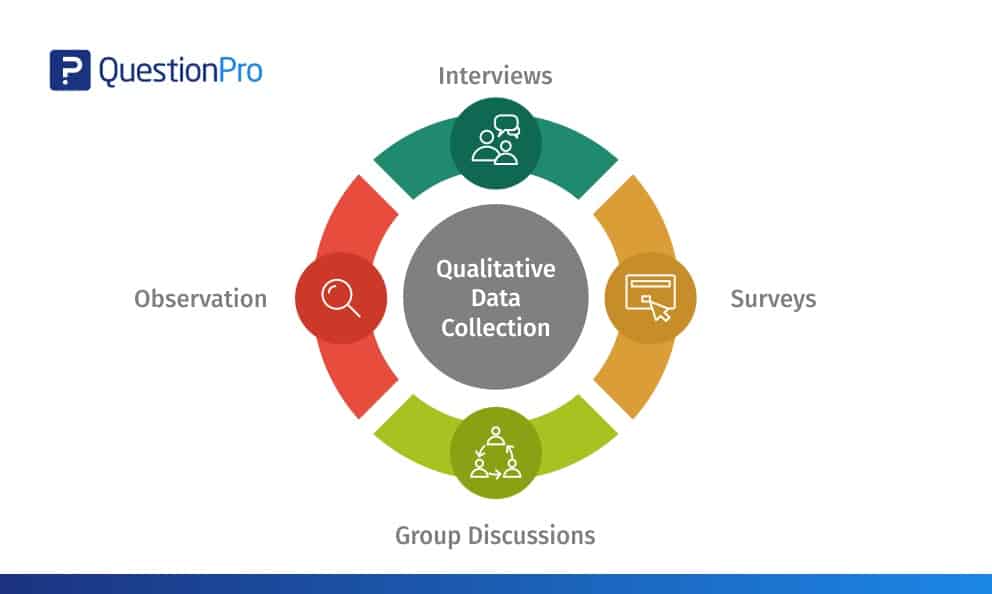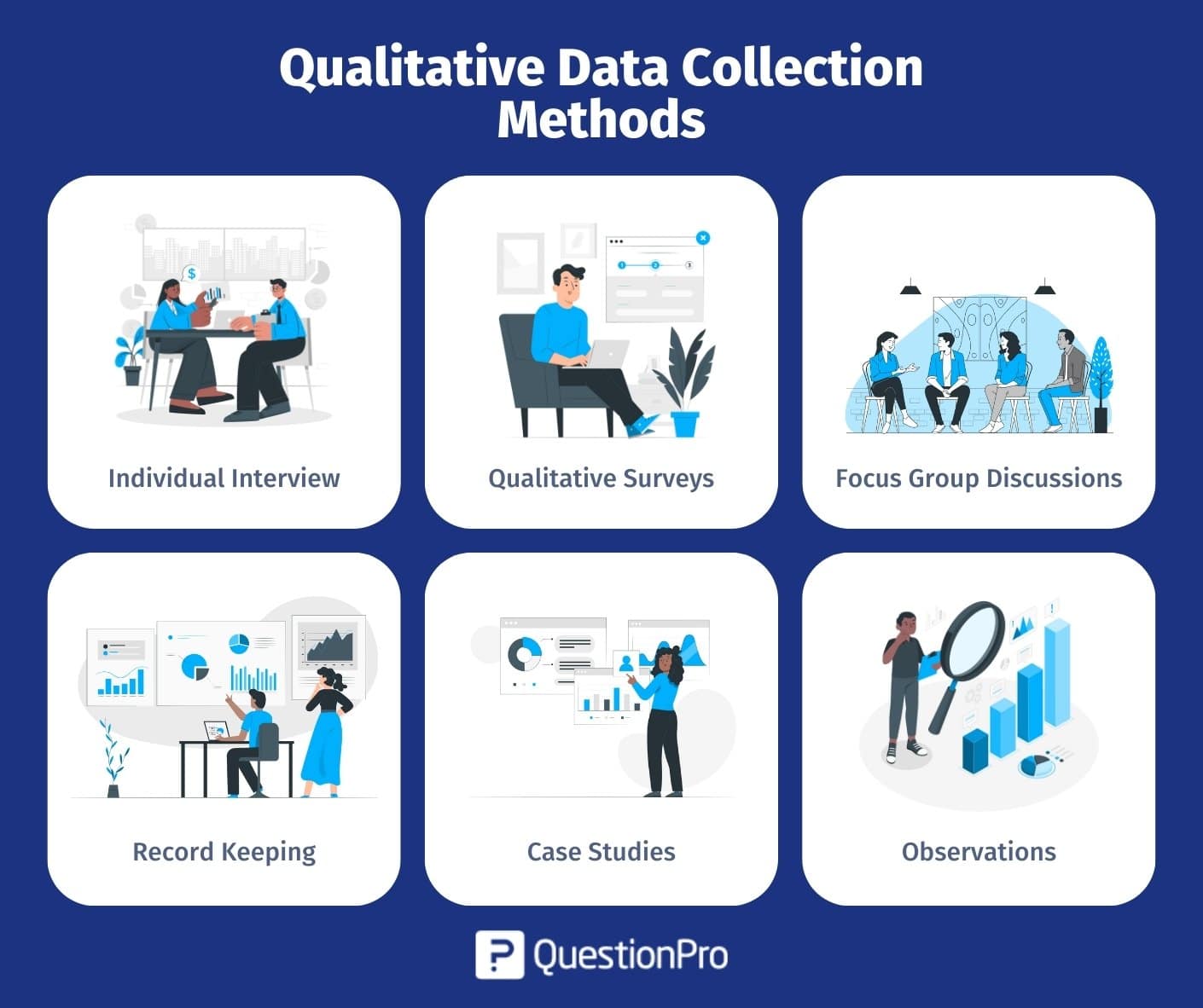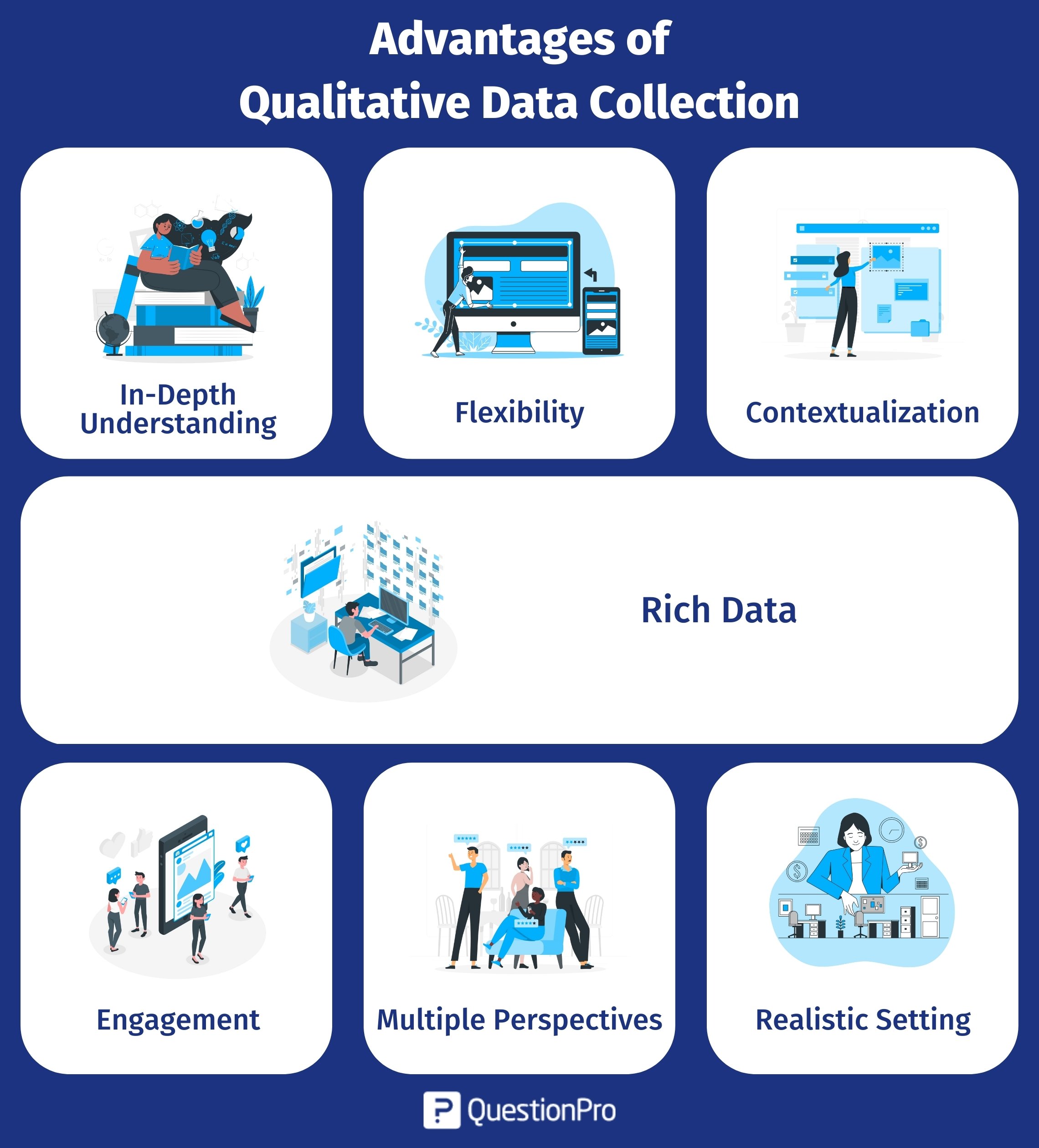
If you want to go beyond numbers and really understand how people think and feel, qualitative data collection methods are the way to do it. These methods focus on gathering in-depth insights into the “why” and “how” behind people’s actions and experiences. Instead of just relying on statistics, you get detailed, personal feedback that helps you understand your audience on a deeper level.
Several methods are used to collect qualitative data, including interviews, surveys, focus groups, and observations. Understanding the various methods used for gathering qualitative data is essential for successful qualitative research.
In this blog, we will discuss qualitative data, its processes, and its collection methods.
What is Qualitative Data?
Qualitative data is information that describes and explains something. It can be seen, observed, and written down.
This data type is non-numerical in nature. This type of data is collected through methods of observations, one-to-one interviews, conducting focus groups, and similar methods.
Qualitative data in statistics is also known as categorical data – data that can be arranged categorically based on the attributes and properties of a thing or a phenomenon.
It’s pretty easy to understand the difference between qualitative and quantitative data. Qualitative data does not include numbers in its definition of traits, whereas quantitative research data is all about numbers.
- The cake is orange, blue, and black in color (qualitative).
- Females have brown, black, blonde, and red hair (qualitative).
What Are Qualitative Data Collection Methods?
Qualitative data collection methods are ways to gather information that helps you understand people’s thoughts, feelings, and experiences. Unlike numbers and statistics, this type of data is more about understanding the “why” and “how” behind something. It’s like having a conversation to get deeper insights into what people think or feel.
The data collected through qualitative methods are often subjective, open-ended, and unstructured and can provide a rich understanding of complex social phenomena.
In statistical analysis, the difference between categorical data and numerical data is essential, as categorical data involves distinct categories or labels, while numerical data consists of measurable quantities.
What is the Need For Qualitative Data Collection?
Qualitative research is a type of study carried out with a qualitative approach to understand the exploratory reasons and to assay how and why a specific program or phenomenon operates in the way it is working. A researcher can access numerous qualitative data collection methods that he/she feels are relevant.
Qualitative data collection methods serve the primary purpose of collecting textual data for research and analysis, like thematic analysis. The collected research data is used to examine:
- Knowledge around a specific issue or a program, experience of people.
- Meaning and relationships.
- Social norms and contextual or cultural practices demean people or impact a cause.
The qualitative data is textual or non-numerical. It covers mostly the images, videos, texts, and written or spoken words by the people. You can opt for any digital data collection methods, like structured or semi-structured surveys, or settle for the traditional approach comprising individual interviews, group discussions, etc.
Are you curious to know about Best Data Collection Tools? QuestionPro recently published a blog about it. Explore it to learn more.
Effective Qualitative Data Collection Methods
Data at hand leads to a smooth process ensuring all the decisions made are for the business’s betterment. You will be able to make informed decisions only if you have relevant data.
Well! With quality data, you will improve the quality of decision-making. You will also improve the quality of the results you expect from any effort.
Qualitative data collection methods are exploratory. Those are usually more focused on gaining insights and understanding the underlying reasons by digging deeper.
Although quantitative data cannot be quantified, measuring it or analyzing qualitative data might become an issue. Due to the lack of measurability, collection methods of qualitative data are primarily unstructured or structured in rare cases – that too to some extent.
Let’s explore the most common methods used for the collection of qualitative data:

Individual interview
It is one of the most trusted, widely used, and familiar qualitative data collection methods primarily because of its approach. An individual or face-to-face interview is a direct conversation between two people with a specific structure and purpose.
The interview questionnaire is designed to elicit the interviewee’s knowledge or perspective related to a topic, program, or issue.
At times, depending on the interviewer’s approach, the conversation can be unstructured or informal but focused on understanding the individual’s beliefs, values, understandings, feelings, experiences, and perspectives on an issue.
More often, the interviewer chooses to ask open-ended questions in individual interviews. If the interviewee selects answers from a set of given options, it becomes a structured, fixed response or a biased discussion.
The individual interview is an ideal qualitative data collection method. Particularly when the researchers want highly personalized information from the participants. The individual interview is a notable method if the interviewer decides to probe further and ask follow-up questions to gain more insights.
Qualitative surveys
To develop an informed hypothesis, many researchers use qualitative research surveys for data collection or to collect a piece of detailed information about a product or an issue. If you want to create questionnaires for collecting textual or qualitative data, then ask more open-ended questions.
To answer such qualitative research questions, the respondent has to write his/her opinion or perspective concerning a specific topic or issue. Unlike other collection methods, online surveys have a wider reach. People can provide you with quality data that is highly credible and valuable.
Paper surveys
Paper surveys are frequently used for qualitative data collection from the participants. The survey consists of short text questions, which are often open-ended.
These questions’ motive is to collect as much detailed information as possible in the respondents’ own words. More often, the survey questionnaires are designed to collect standardized data and hence used to collect responses from a larger population or large sample size.
Online surveys
An online survey or a web survey is prepared using a prominent online survey software and either uploaded to a website or emailed to the selected sample size with the motive of collecting reliable online data.
Instead of writing down responses, the respondents use computers and keyboards to type their answers. With an online survey questionnaire, it becomes easier and smoother to collect qualitative data.
In addition to that, online surveys have a wider reach, and the respondent is not pressured to answer each question under the interviewer’s supervision. One of the significant benefits that online surveys offer is that they allow the respondents to take the survey on any device.
Focus group discussions
Focus group discussions can also be considered a type of interview, but it is conducted in a group discussion setting. Usually, the focus group consists of 8 – 10 people (the size may vary depending on the researcher’s requirement). The researchers ensure appropriate space is given to the participants to discuss a topic or issue in a context. The participants are allowed to either agree or disagree with each other’s comments.
With a focused group discussion, researchers know how a particular group of participants perceives the topic. Researchers analyze what participants think of an issue, the range of opinions expressed, and the ideas discussed. The data is collected by noting down the variations or inconsistencies (if any exist) in the participants, especially in terms of belief, experiences, and practice.
The participants of focused group discussions are selected based on the topic or issues for which the researcher wants actionable insights. For example, if the research is about the recovery of college students from drug addiction. The participants have to be college students studying and recovering from drug addiction.
Other parameters such as age, qualification, financial background, social presence, and demographics are also considered, but not primarily, as the group needs diverse participants. Frequently, the qualitative data collected through focused group discussion is more descriptive and highly detailed.
Record keeping
This method uses reliable documents and other sources of information that already exist as the data source. This information can help with the new study. It’s a lot like going to the library. There, you can look through books and other sources to find information that can be used in your research.
Case studies
In this method, data is collected by looking at case studies in detail. This method’s flexibility is shown by the fact that it can be used to analyze both simple and complicated topics. This method’s strength is how well it draws conclusions from a mix of one or more qualitative data collection methods.
Observations
Observation is one of the traditional methods of qualitative data collection. It is used by researchers to gather descriptive analysis data by observing people and their behavior at events or in their natural settings. In this method, the researcher fully involves themselves in observing people and taking part in the activities while making notes.
There are two main types of observation:
- Covert: In this method, the observer is concealed without letting anyone know that they are being observed. For example, a researcher studying the rituals of a wedding in nomadic tribes must join them as a guest and quietly see everything.
- Overt: In this method, everyone is aware that they are being watched. For example, A researcher or an observer wants to study the wedding rituals of a nomadic tribe. To proceed with the research, the observer or researcher can reveal why he is attending the marriage and even use a video camera to shoot everything around him.
Observation is a useful method of qualitative data collection, especially when you want to study the ongoing process, situation, or reactions on a specific issue related to the people being observed.
When you want to understand people’s behavior or their way of interaction in a particular community or demographic, you can rely on the observation data. Remember, if you fail to get quality data through surveys, qualitative interviews, or group discussions, rely on observation.
It is the best and most trusted collection method of qualitative data to generate qualitative data as it requires equal to no effort from the participants.
Qualitative Data Analysis Process
You invested time and money acquiring your data, so analyze it. It’s necessary to avoid being in the dark after all your hard work. Qualitative data analysis starts with knowing its two basic techniques, but there are no rules.
- Deductive Approach: The deductive data analysis uses a researcher-defined structure to analyze qualitative data. This method is quick and easy when a researcher knows what the sample population will say.
- Inductive Approach: The inductive technique has no structure or framework. When a researcher knows little about the event, an inductive approach is applied.
Whether you want to analyze qualitative data from a one-on-one interview or a survey, these simple steps will ensure a smooth qualitative data analysis.
Step 1: Collect your Data
After collecting all the data, it is mostly unstructured and sometimes unclear. Arranging your data is the first stage in qualitative data analysis. So, researchers must transcribe data before analyzing it.
Step 2: Organize all your Data
After transforming and arranging your data, the next step is to organize it. One of the best ways to organize the data is to think back to your research goals and then organize the data based on the research questions you asked.
Step 3: Set a Code to the Data Collected
Setting up appropriate codes for the collected data gets you one step closer. Coding is one of the most effective methods for compressing a massive amount of data. It allows you to derive theories from relevant research findings.
Step 4: Validate your Data
Qualitative data analysis success requires data validation. Data validation should be done throughout the research process, not just once. There are two sides to validating data:
- The accuracy of your research design or methods.
- Reliability—how well the approaches deliver accurate data.
Step 5: Concluding the Analysis Process
Finally, conclude your data in a presentable report. The report should describe your research methods, their pros and cons, and research limitations. Your report should include findings, inferences, and future research.
QuestionPro is an excellent online survey software that offers a variety of qualitative data analysis tools to help businesses and researchers in making sense of their data. Users can use many different qualitative analysis methods to learn more about their data.
Users of QuestionPro can see their data in different charts and graphs, which makes it easier to spot patterns and trends. It can help researchers and businesses learn more about their target audience, which can lead to better decisions and better results.
Choosing the right software can be tough. Whether you’re a researcher, business leader, or marketer, check out the top 10 qualitative data analysis software for analyzing qualitative data.
Advantages of Qualitative Data Collection
Qualitative data collection has several advantages, including:

- In-depth understanding: It provides in-depth information about attitudes and behaviors, leading to a deeper understanding of the research.
- Flexibility: The methods allow researchers to modify questions or change direction if new information emerges.
- Contextualization: Qualitative research data is in context, which helps to provide a deep understanding of the experiences and perspectives of individuals.
- Rich data: It often produces rich, detailed, and nuanced information that cannot be captured through numerical data.
- Engagement: The methods, such as interviews and focus groups, involve active meetings with participants, leading to a deeper understanding.
- Multiple perspectives: This can provide various views and a rich array of voices, adding depth and complexity.
- Realistic setting: It often occurs in realistic settings, providing more authentic experiences and behaviors.
Conclusion
Qualitative research methods are best for collecting qualitative data and identifying the behavior and patterns governing social conditions, issues, or topics. It spans a step ahead of quantitative data as it fails to explain the reasons and rationale behind a phenomenon, but qualitative data quickly does.
Qualitative research is one of the best tools to identify behaviors and patterns governing social conditions. It goes a step beyond quantitative data by providing the reasons and rationale behind a phenomenon that cannot be explored quantitatively.
With QuestionPro, you can use it for qualitative data collection through various methods. Using Our robust suite correctly, you can enhance the quality and integrity of the collected data.
Frequently Asked Questions (FAQs)
Qualitative methods provide deeper insights than numbers alone. They help you explore complex topics, understand motivations, and gather rich feedback. These methods are especially useful when you need to understand the underlying reasons for people’s actions or preferences.
Choosing the right method depends on your research goals. If you want detailed individual insights, interviews work well. For group dynamics, focus groups are better. If you want to observe natural behavior, observation is ideal. Consider what kind of data will give you the most valuable insights.
Some challenges include managing large amounts of data, ensuring participant honesty, and avoiding researcher bias during analysis. Qualitative research also requires more time and effort compared to quantitative methods, as it involves in-depth interviews and analysis.







